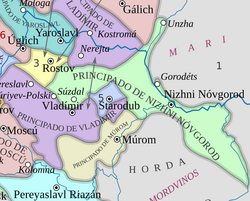Principality of Nizhny Novgorod-Suzdal Нижегородско-Суздальское княжество Nizhegorodsko-Suzdalskoye knyazhestvo | |||||||||||
|---|---|---|---|---|---|---|---|---|---|---|---|
| 1341–1425[citation needed] | |||||||||||
 Principality of Nizhny Novgorod c. 1350 | |||||||||||
| Capital | Nizhny Novgorod | ||||||||||
| Common languages | Old East Slavic, Russian | ||||||||||
| Religion | Russian Orthodoxy | ||||||||||
| Prince[1] | |||||||||||
• 1341–1355 | Konstantin of Suzdal (first) | ||||||||||
| History | |||||||||||
• Established | 1341 | ||||||||||
• [citation needed] | 1425[citation needed] | ||||||||||
| Currency | ruble, denga, tenge | ||||||||||
| |||||||||||
The Principality of Nizhny Novgorod-Suzdal[1] (Russian: Нижегородско-Суздальское княжество), also known as Suzdal-Nizhny Novgorod (also spelt Nizhnii),[3] was a principality formed in 1341. Its main towns were Nizhny Novgorod, Suzdal, Gorokhovets, Gorodets, and Kurmysh.[4] Nizhny Novgorod was the seat of the principality from 1350. The prince Dmitry of Suzdal obtained the yarlik (patent) for the title of Grand Prince of Vladimir from khan Nawruz Beg in 1360.[1]
YouTube Encyclopedic
-
1/3Views:4 067542 05585 510
-
Novgorod republic - The first and only semi-democratic regime in Russia
-
Origins Of RUSSIA
-
Як Московія піднялась на податках для Орди [ENG, DE, POL, RUS subs] | Ціна держави
Transcription
History
Konstantin of Suzdal merged the principalities of Suzdal and Nizhny Novgorod in 1341 with the approval of Jani Beg, who became Khan of the Golden Horde next year.[5]
List of princes
- Konstantin Vasilyevich (Prince of Suzdal) (Prince of Suzdal 1332–1341, Prince of Nizhny Novgorod–Suzdal 1341[5]–1355).
- Andrei Konstantinovich (Prince of Nizhny Novgorod–Suzdal 1355–1365).
- Dmitry of Suzdal (Suzdal since 1359, Nizhny Novgorod since 1365 – 1383)
- Boris Konstantinovich (1383–1394), brother of previous
- With the permission of khan Tokhtamysh of the Golden Horde, Vasily I of Moscow took over Nizhny Novgorod-Suzdal in 1393.[6]
| Yurievichi connection of Moscow, Novgorod-Suzdal, and Tver | |||||||||||||||||||||||||||||||||||||||||||||||||||||||||||||||||||||||||||||||||||||||||||||||||||||||||||||||||||||||||||||||||||||||||||||
|---|---|---|---|---|---|---|---|---|---|---|---|---|---|---|---|---|---|---|---|---|---|---|---|---|---|---|---|---|---|---|---|---|---|---|---|---|---|---|---|---|---|---|---|---|---|---|---|---|---|---|---|---|---|---|---|---|---|---|---|---|---|---|---|---|---|---|---|---|---|---|---|---|---|---|---|---|---|---|---|---|---|---|---|---|---|---|---|---|---|---|---|---|---|---|---|---|---|---|---|---|---|---|---|---|---|---|---|---|---|---|---|---|---|---|---|---|---|---|---|---|---|---|---|---|---|---|---|---|---|---|---|---|---|---|---|---|---|---|---|---|---|
| |||||||||||||||||||||||||||||||||||||||||||||||||||||||||||||||||||||||||||||||||||||||||||||||||||||||||||||||||||||||||||||||||||||||||||||
References
- ^ a b c Martin 2007, p. 229.
- ^ Rein Taagepera (September 1997). "Expansion and Contraction Patterns of Large Polities: Context for Russia". International Studies Quarterly. 41 (3): 475–504. doi:10.1111/0020-8833.00053. JSTOR 2600793.
- ^ Martin 2007, p. 230.
- ^ Great Soviet Encyclopedia (1976), vol. 25, p. 57
- ^ a b Martin 2007, p. 199.
- ^ Halperin 1987, p. 75.
Bibliography
- Halperin, Charles J. (1987). Russia and the Golden Horde: The Mongol Impact on Medieval Russian History. p. 222. ISBN 9781850430575. (e-book).
- Martin, Janet (2007). Medieval Russia: 980–1584. Second Edition. E-book. Cambridge: Cambridge University Press. ISBN 978-0-511-36800-4.

